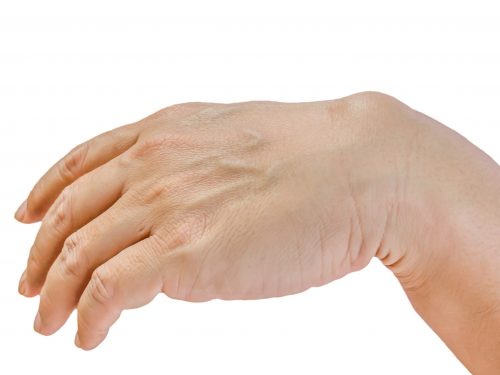Ganglions of the wrist and hand
Ganglion cysts are the most common benign lumps in the hand, arising from a joint or tendon sheath. The walls of the cyst are made of connective tissue, and the cyst is filled with a thick clear fluid. The most common locations are the top of the wrist, the palm side of the wrist, the base of the finger on the palm side, and the top of the end joint of the finger.
In most patients, ganglion cysts do not require treatment. However, if the cyst is painful, interferes with function, or has an unacceptable appearance, there are several treatment options available.

Ganglion SURGERY – facts
| Length of surgery | 1 hour |
| Anaesthesia | Local or General anaesthetic |
| Hospital stay | Day case |
| Risks/complications of surgery | Frequent: Swelling, stiffness, discomfort on movement Infrequent: Infection, bleeding (haematoma), delayed wound healing, painful scar, damage to the nerve, recurrence, incomplete resolution of symptoms, complex regional pain syndrome |
| Recovery | 1-2 weeks until return to office work |
| Driving | 1-2 weeks |
| Hand position | Elevation above the heart level |
| Follow up | 1 week, 6 weeks, 3 months, 6 months |
| Duration of results | Permanent |
DOWNLOAD FURTHER INFORMATION
Ganglion Surgery
Any hand surgery procedure is a personal choice and understandably there are a number of questions that arise. This information sheet is a general guide for patients considering ganglion treatment under the care of Dr Mackenzie. It should provide the answers to some questions that you may have.
What is a ganglion?
A ganglion is a fluid-filled sac that appears as a lump under the skin. It is often painless, but depending on its location, it may cause enough discomfort to require treatment.
Ganglion:
- Grows out of the tissues surrounding a joint, such as ligaments, tendon sheaths, and joint linings
- Can be large and obvious or small and deep. It can also fluctuate in size without any special cause or reason
- Occurs most frequently on the joints and tendons of the wrist. Most are found on the top of the wrist and by the nail of the finger or on the front of the finger (called mucous cyst)
- Can appear almost suddenly, or can grow slowly over a period of months or years
- Most often affects people in their 30s and 40s
- More common in women than men
- Doesn’t have a specific cause and is not related to any particular activity
- Ganglion cyst is not cancerous
What are the symptoms of a ganglion?
Many ganglions remain asymptomatic. Some can grow large enough to be unattractive, but otherwise cause no other symptoms. They may not cause any symptoms for months or years and then suddenly cause discomfort or affect range of motion.
The symptoms may include:
- If a ganglion puts pressure on the nerves, it can cause numbness and tingling
- Weakened grip and a reduced range of motion
- Pain when direct pressure is placed on a ganglion
- Ganglions near the fingernail may produce grooves in the nail